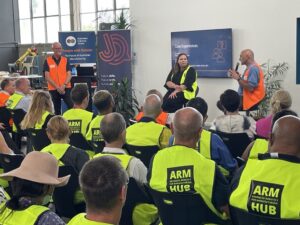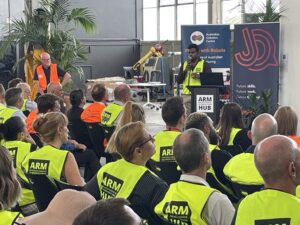Around 120 people attended the launch of Job Queensland’s Advancing Manufacturing: Exploring the human element of the journey key findings at ARM Hub today.
 The report documents two Advanced Manufacturing case studies undertaken by the Australian Cobotics Centre to illustrate the opportunities and challenges faced by manufacturing organisations on their 4.0 journey and highlights the importance of manufacturers engaging their workforce to facilitate change and drive growth.
The report documents two Advanced Manufacturing case studies undertaken by the Australian Cobotics Centre to illustrate the opportunities and challenges faced by manufacturing organisations on their 4.0 journey and highlights the importance of manufacturers engaging their workforce to facilitate change and drive growth.
Case Study 1: Watkins Steel-Holovision is a Brisbane company specialising in structural steel and metalwork fabrication, which services multiple industry sectors. Since 2014, when the company commissioned its first line of robotics, the company has experienced growth averaging 20 per cent year on year.
Case Study 2: B&R Enclosures is a Brisbane-based, family-owned company that designs and manufactures stainless steel, steel and plastic enclosures and cabinet solutions used to house electrical and computer network equipment. Digitisation of business processes is a current focus of B&R’s journey toward Advanced Manufacturing, with the company actively moving from paper-based processes to technology-driven solutions for many aspects of their business.
 Key findings from the two case studies were:
Key findings from the two case studies were:
- Technology investment
Investment in robotics, automation and digitisation is essential to remain globally competitive. Companies that are investing are expanding into new markets, new product lines or becoming more competitive in existing niche markets.
- Investing in re-skilling
Automation is changing jobs. Continued investment in skilling the current workforce, however, ensures workers can be re-deployed and maintain a career in manufacturing. Such investment must happen both at the level of the organisation and sectorwide. More research is required to better support re-skilling and to address future challenges of digitisation in the workforce.
- Expanding skill sets
Workers with a combination of qualifications (e.g. engineering) and ‘craft’ skills (e.g. welding or boilermaking) are most in demand. By supplementing university qualifications with trade knowledge and craft skills, designers and engineers are better able to understand problems, innovate and produce more practical solutions.
- Training partnerships
Partnerships with educational institutions (e.g. schools, TAFEs and universities) and professional associations are essential to building the skills required in the future workforce. These partnerships are also critical to addressing labour shortages and attracting more diverse workers into manufacturing.
- Re-branding manufacturing work
A communication and attraction strategy is needed to promote emerging career opportunities, driven by robotics, automation and digitisation, and to re-frame negative perceptions in the labour market about manufacturing jobs.
- Diversity strategies require research
The number of women in manufacturing appears to be growing and the workforce is becoming more diverse (as noted by those working within it); however, increasing diversity seems to have largely occurred organically. There are few formal strategies to increase diversity and limited research on the barriers to creating a more diverse workforce. More research is required to support organisations and inform their future strategies, including attraction and retention strategies for under-represented groups such as women, workers with a disability, First Nations people and older workers.
- Leader-driven organisational change
Senior leaders play a pivotal role in shaping organisational cultures in which technology has been embraced as a means by which the organisation can innovate. The behaviour and commitment of leaders drives the ‘mindset shift’ that is required for workers to embrace automation and digitisation not as a threat but as an opportunity to improve the way work is done.
- Capabilities for managing the external environment
Manufacturing capability can be further strengthened by developing skills in dealing with the external environment of the business. For example, managing cash flow, accessing finance and investment, making timely adoption of technology, managing digital threats such as cyber attacks, negotiating or adapting to supply chain opportunities.
Mr Des Watkins, Managing Director, of Watkins Steel and Kimberley Davis, Group HR Manager of B&R Enclosures discussed the findings with ACC Research Program Co-Lead (Human-Robot Workforce program), Professor Greg Hearn. Des spoke of the importance of preparing the future workforce for flexibility and Kimberley called for multi-disciplinary teams, such as engineers, HR workers and others, to collaborate in implementing 4.0 solutions.
 ARM Hub COO Mr Samuel Jesuadian presented on outcomes of Advanced Manufacturing projects at ARM Hub and led a small group on a tour of the ARM Hub factory.
ARM Hub COO Mr Samuel Jesuadian presented on outcomes of Advanced Manufacturing projects at ARM Hub and led a small group on a tour of the ARM Hub factory.
The Advancing Manufacturing: Exploring the human element of the journey report also details progress against Priority Action Areas identified in JQ’s 2018 Advancing Manufacturing Skills: A Skills, Training and Workforce Development Strategy for the Manufacturing Industry in Queensland.